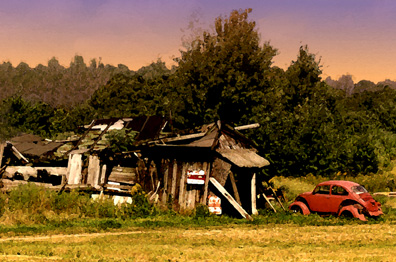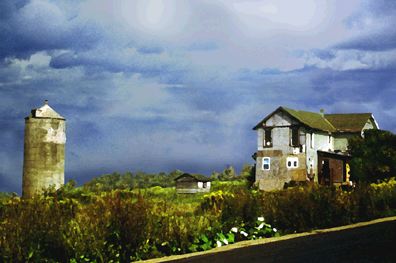| Back
Road Trip
by James Kunstler on January 16, 2006 in www.Kunstler.com
The past week's adventure took me up the back roads through a little
corner of eastern upstate New York into Vermont to Burlington, to
tape a public TV show. Are you indignant to read that I drove there
in a conventional gasoline-powered automobile? Guess what -- one
doesn't have a choice, given the pathetic condition of our railroads,
and I haven't ordered my soy-diesel-powered one-man zeppelin yet.
Anyway, the subject is what I saw along the way.
It would be hard to imagine a sadder landscape than these rural
backwaters along the New York / Vermont border. Geographically they
are still beautiful. It's a region of tender hills, well-wooded
now, and ribboned with trout streams. It's the human furnishings
that are desolate and what they say about what we have become as
a nation. This was a farming region of course, and the re-growth
of the woods is a symptom of farming's decline the past fifty years.
Dairying was the big thing through the first three-quarters of the
20th century. But regional milk production became irrelevant during
the decades of cheap oil, when New Yorkers could just as easily
get milk and cheese from Wisconsin or California. So now only a
few relic farms still operate. Every building in the landscape related
to farming is now decrepit. Siding and shingles have peeled off
the barns. The sills are rotting and the ridgeboards sag. The tractor
sheds are too far gone to keep tractors in, so the machines sit
out in the rain now. The older houses -- many of them dating from
the Greek Revival of the 1850s -- are subject to indignities beyond
simple neglect. Many are partially cocooned in plastic, because
fixing the wooden parts was too expensive, or just too difficult
for people whose skills are now limited to operating cars, televisions,
and forklifts. The yards are littered with plastic debris: tricycles,
hoses, and patio chairs disintegrating under the daily ultraviolet
-- and you could see it all because a week of January temperatures
into the 50s melted all the snow cover off.
You can track the decades of overgrowth in the pastures: sumac and
poplar in the early going, then regular trees. In many places, stone
walls from the 19th century run along the roads in woods that were
sheep meadows a hundred and fifty years ago. You have to wonder
how long all that wood will be there now, with heating bills up
50 percent this year and no relief in sight. Indeed, I wonder if
the remnant of people living here will have any idea what to do
with their land, when the forklift jobs in the Target Store regional
warehouse thirty-eight miles away are no longer there. I'd like
to suppose that even people unaccustomed to challenges can be resilient
and resourceful when they simply have to be. But if the televisions
stay on, they may just choose to die in front of them.
The towns along way -- Salem, Granville, Fair Haven -- may be even
sadder than the farms. All civic vitality seems to have been drained
out of them by a persistent wasting disease. Little of any value
has been built in decades, and certainly nothing with any beauty.
Here and there gas stations bloated into snack marts vie for supremacy
of the highway intersections, but the little downtowns with their
vacant storefronts echo with loss and grief. Everything fixed has
been fixed badly. The houses are encased in plastic siding, grimy
with years of tailpipe emissions. Here and there a screw falls out
of a sofit and a dangling plastic panel flutters in the wind. The
town streets are empty. The windows are broken in the small factories
along the trout streams. Only the county highways that turn into
the Main Streets show any signs of life, and that, of course, is
the life of the highway itself, the endless cavalcade of motoring.
Cars and trucks are the sole investments made here.

Swede
Road in western New York has still this working garage
I traverse this landscape goggling at the sights in wonder and nausea.
This part of America has become something worse than a former Soviet
backwater, something sadder. In these places, we have managed to
overcome even the hard-won fruits of enterprise achieved by the
independent people who preceded those alive now. Everything they
wrested from the land has been thrown away, or allowed to rot in
place -- so that more attention can be paid to televised entertainments.
Eventually, I reached the outer asteroid belt of car dealerships
and fried food shacks that precedes Burlington. Here the mood switched
from depressed to manic. Here, America was still busy, actively
destroying itself. Given what we have managed to make of a farming
and small town landscape, you had to imagine what these suburban
vistas would be like fifty years from now.
|

